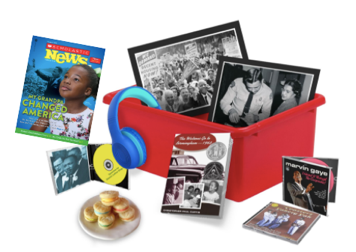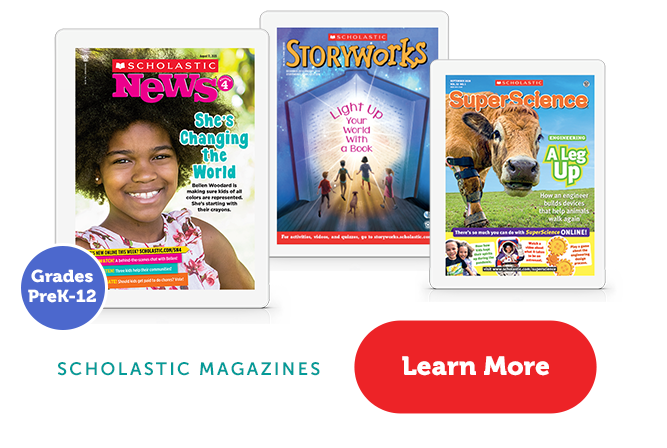5 Secrets to Boosting Background Knowledge


Pop quiz: What’s the single most important factor in reading comprehension? More and more education researchers tell us the key is factual knowledge. Simply put, knowing about a topic makes reading about it easier.
At Scholastic Magazines+, we’re excited to bring you these five teacher-tested, easy-to-use strategies for boosting background knowledge in the virtual classroom. To make it even easier, we’re sharing engaging nonfiction videos and stories from our award-winning digital + print resources for elementary school.
- Assess and Activate
Start by identifying knowledge gaps. Try these strategies with your students:
Snowball Discussion: Have your students virtually meet up in pairs of two, then pair them with another group, creating a group of four, and so on, until your whole class is engaged in a discussion together.
Draw What You Know: This is a simple, fun and creative way to assess knowledge and spot misconceptions. Ask students at home to make a drawing about a topic and submit a photo of their work to showcase in your virtual classroom.
Mad Minute: Give students 60 seconds to respond to a question or make a list of items related to a topic. Have them type their responses in your video chat and choose a few students to share their answers with the class.
- Make Cross-Curricular Connections
To strengthen and deepen background knowledge, double up—combine two content areas in one lesson. For example, embed social studies, science or math in reading.
Try it with your choice of these thrilling narrative nonfiction stories; just share the link with your students:
Escape from Pompeii (Scholastic News for grade 3)
The Great Gorilla Count (DynaMath for grades 3–5)
Back to the Moon! (SuperScience for grades 3–6)
The Road to Revolution (Scholastic News for grade 4)
The Mystery of Roanoke (Storyworks for grades 4–6)
- Use Sensory Immersion
For a more memorable and hands-on learning experience, surround students with information that stimulates their senses. You can create a sensory book box for the classroom or a virtual book box for remote learning. Fill the box with items that evoke details from a book you’re reading—or items that relate to its subject matter but don’t appear in the book.
Provide relevant photos or magazines to set the scene and include significant people and historical moments connected to the book’s setting.
Listen to music from the book’s time period.
Create a menu or provide food the characters would eat.

- Watch and Learn
Short nonfiction videos are always a hit with kids and perfect to share with remote learners.
They’re also proven to help students process information better. The real-world footage grabs their attention and helps them connect to the world around them. Use these videos to captivate early learners and even encourage dancing to get them moving.
Try this Dance Break from Let’s Find Out (kindergarten) and Scholastic News (grades 1 and 2).
Show The Truth About Sharks, from Scholastic News, to elementary schoolers.
- Bring the Outside In
Nothing builds background knowledge like real-life experiences do. Incorporate the outside world in the beginning of a unit or lesson, so students can apply what they just learned to what they read.
Virtual field trips enhance kids’ understanding by letting them explore a topic firsthand.
Virtual visits to museums or animal sanctuaries are widely available online for educators.
Guest speakers such as historians, scientists, authors and community helpers let students learn directly from experts.
Boost Knowledge with Us All Year Long!
Now that you’ve got must-try ideas for building background knowledge in the virtual classroom, get the engaging, flexible digital resources you need throughout the school year with Scholastic Magazines+. Receive full access to our easy-to-use digital platform that lets you share texts, videos, activities & more with students and their families. Just choose what’s right for you: Digital-Only subscriptions or Print + Digital subscriptions that include thrilling print magazines for every student.
Pop quiz: What’s the single most important factor in reading comprehension? More and more education researchers tell us the key is factual knowledge. Simply put, knowing about a topic makes reading about it easier.
At Scholastic Magazines+, we’re excited to bring you these five teacher-tested, easy-to-use strategies for boosting background knowledge in the virtual classroom. To make it even easier, we’re sharing engaging nonfiction videos and stories from our award-winning digital + print resources for elementary school.
- Assess and Activate
Start by identifying knowledge gaps. Try these strategies with your students:
Snowball Discussion: Have your students virtually meet up in pairs of two, then pair them with another group, creating a group of four, and so on, until your whole class is engaged in a discussion together.
Draw What You Know: This is a simple, fun and creative way to assess knowledge and spot misconceptions. Ask students at home to make a drawing about a topic and submit a photo of their work to showcase in your virtual classroom.
Mad Minute: Give students 60 seconds to respond to a question or make a list of items related to a topic. Have them type their responses in your video chat and choose a few students to share their answers with the class.
- Make Cross-Curricular Connections
To strengthen and deepen background knowledge, double up—combine two content areas in one lesson. For example, embed social studies, science or math in reading.
Try it with your choice of these thrilling narrative nonfiction stories; just share the link with your students:
Escape from Pompeii (Scholastic News for grade 3)
The Great Gorilla Count (DynaMath for grades 3–5)
Back to the Moon! (SuperScience for grades 3–6)
The Road to Revolution (Scholastic News for grade 4)
The Mystery of Roanoke (Storyworks for grades 4–6)
- Use Sensory Immersion
For a more memorable and hands-on learning experience, surround students with information that stimulates their senses. You can create a sensory book box for the classroom or a virtual book box for remote learning. Fill the box with items that evoke details from a book you’re reading—or items that relate to its subject matter but don’t appear in the book.
Provide relevant photos or magazines to set the scene and include significant people and historical moments connected to the book’s setting.
Listen to music from the book’s time period.
Create a menu or provide food the characters would eat.

- Watch and Learn
Short nonfiction videos are always a hit with kids and perfect to share with remote learners.
They’re also proven to help students process information better. The real-world footage grabs their attention and helps them connect to the world around them. Use these videos to captivate early learners and even encourage dancing to get them moving.
Try this Dance Break from Let’s Find Out (kindergarten) and Scholastic News (grades 1 and 2).
Show The Truth About Sharks, from Scholastic News, to elementary schoolers.
- Bring the Outside In
Nothing builds background knowledge like real-life experiences do. Incorporate the outside world in the beginning of a unit or lesson, so students can apply what they just learned to what they read.
Virtual field trips enhance kids’ understanding by letting them explore a topic firsthand.
Virtual visits to museums or animal sanctuaries are widely available online for educators.
Guest speakers such as historians, scientists, authors and community helpers let students learn directly from experts.
Boost Knowledge with Us All Year Long!
Now that you’ve got must-try ideas for building background knowledge in the virtual classroom, get the engaging, flexible digital resources you need throughout the school year with Scholastic Magazines+. Receive full access to our easy-to-use digital platform that lets you share texts, videos, activities & more with students and their families. Just choose what’s right for you: Digital-Only subscriptions or Print + Digital subscriptions that include thrilling print magazines for every student.
Pop quiz: What’s the single most important factor in reading comprehension? More and more education researchers tell us the key is factual knowledge. Simply put, knowing about a topic makes reading about it easier.
At Scholastic Magazines+, we’re excited to bring you these five teacher-tested, easy-to-use strategies for boosting background knowledge in the virtual classroom. To make it even easier, we’re sharing engaging nonfiction videos and stories from our award-winning digital + print resources for elementary school.
- Assess and Activate
Start by identifying knowledge gaps. Try these strategies with your students:
Snowball Discussion: Have your students virtually meet up in pairs of two, then pair them with another group, creating a group of four, and so on, until your whole class is engaged in a discussion together.
Draw What You Know: This is a simple, fun and creative way to assess knowledge and spot misconceptions. Ask students at home to make a drawing about a topic and submit a photo of their work to showcase in your virtual classroom.
Mad Minute: Give students 60 seconds to respond to a question or make a list of items related to a topic. Have them type their responses in your video chat and choose a few students to share their answers with the class.
- Make Cross-Curricular Connections
To strengthen and deepen background knowledge, double up—combine two content areas in one lesson. For example, embed social studies, science or math in reading.
Try it with your choice of these thrilling narrative nonfiction stories; just share the link with your students:
Escape from Pompeii (Scholastic News for grade 3)
The Great Gorilla Count (DynaMath for grades 3–5)
Back to the Moon! (SuperScience for grades 3–6)
The Road to Revolution (Scholastic News for grade 4)
The Mystery of Roanoke (Storyworks for grades 4–6)
- Use Sensory Immersion
For a more memorable and hands-on learning experience, surround students with information that stimulates their senses. You can create a sensory book box for the classroom or a virtual book box for remote learning. Fill the box with items that evoke details from a book you’re reading—or items that relate to its subject matter but don’t appear in the book.
Provide relevant photos or magazines to set the scene and include significant people and historical moments connected to the book’s setting.
Listen to music from the book’s time period.
Create a menu or provide food the characters would eat.

- Watch and Learn
Short nonfiction videos are always a hit with kids and perfect to share with remote learners.
They’re also proven to help students process information better. The real-world footage grabs their attention and helps them connect to the world around them. Use these videos to captivate early learners and even encourage dancing to get them moving.
Try this Dance Break from Let’s Find Out (kindergarten) and Scholastic News (grades 1 and 2).
Show The Truth About Sharks, from Scholastic News, to elementary schoolers.
- Bring the Outside In
Nothing builds background knowledge like real-life experiences do. Incorporate the outside world in the beginning of a unit or lesson, so students can apply what they just learned to what they read.
Virtual field trips enhance kids’ understanding by letting them explore a topic firsthand.
Virtual visits to museums or animal sanctuaries are widely available online for educators.
Guest speakers such as historians, scientists, authors and community helpers let students learn directly from experts.
Boost Knowledge with Us All Year Long!
Now that you’ve got must-try ideas for building background knowledge in the virtual classroom, get the engaging, flexible digital resources you need throughout the school year with Scholastic Magazines+. Receive full access to our easy-to-use digital platform that lets you share texts, videos, activities & more with students and their families. Just choose what’s right for you: Digital-Only subscriptions or Print + Digital subscriptions that include thrilling print magazines for every student.
